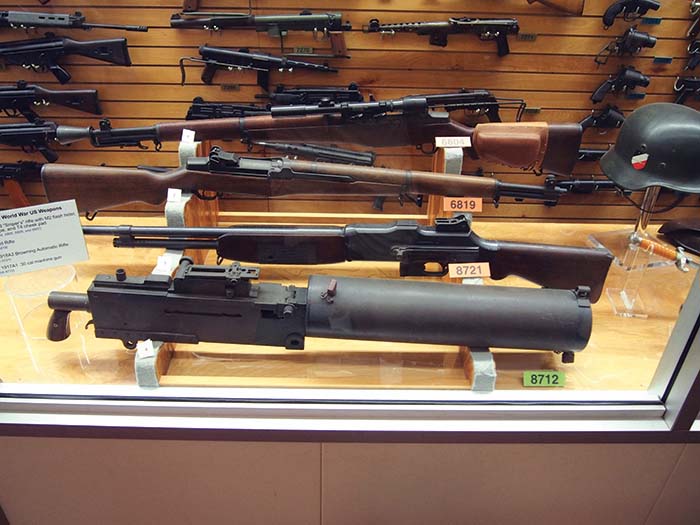A Browning 1919A1 .30 caliber machine gun (bottom) along with other World War II era small arms including a Browning Automatic Rifle (BAR) and two M1 Garand rifles (top).
By Peter Suciu
It isn’t hard to find a firearms museum that has something special, but what sets the Rock Island Arsenal Museum apart from other military and firearms museums is that it in itself is truly very special. Located at the Rock Island Arsenal in Illinois, the museum occupies the room in Building 60 that once housed Shop B where the Model 1903 Springfield receiver was produced during the First World War.
Today the museum is home to one of the finest collections of small arms in North America, and moreover it is the second oldest U.S. Army Museum in the United States after the West Point Museum. Established on July 4, 1905, the museum has only been closed twice – during World War I and World War II to provide more space for the manufacturing facilities. Today the museum’s collection now includes some 12,000 items in total; with nearly 70 percent of the museum’s firearms on permanent display.

The only downside to displaying a collection of this size is that it isn’t presented in any chronological order, nor is it broken down by nation or even weapon type. Instead the collection features vintage black powder long guns on the wall with modern MAC 10s.
“We’d like to reorganize the collection but it is impossible at the present time,” said Kris Gayman Leinicke, director of the Rock Island Arsenal Museum. “With so many firearms there is simply no way to take everything down and reorganize it without closing the museum for days or weeks.”
The irony in this is that the museum had fairly humble beginnings when 110 years ago Chief of Ordnance Major General William Crozier supplied 15 boxes of ordnance and small arms with the intent to preserve it as a military museum at the Rock Island Arsenal. From those 15 boxes the collection has grown and greatly expanded. Today the collection of small arms is displayed on nearly two full walls with firearms dating back to the American Revolution and continuing to the modern day.
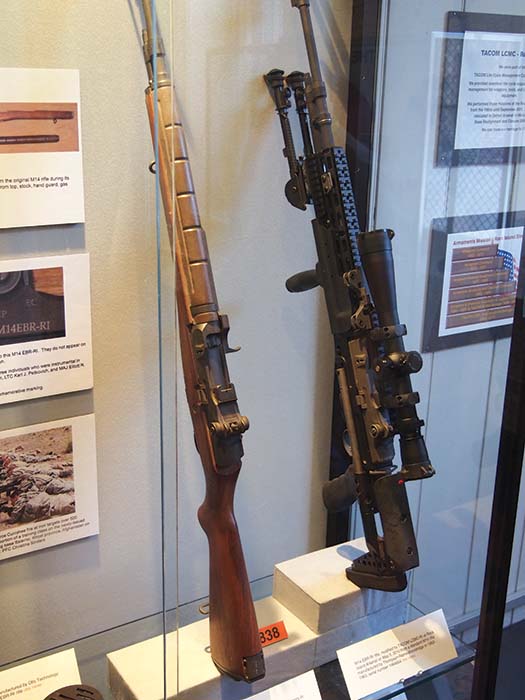
The oldest piece in the collection is believed to be a “wall gun” that features a 1 3/16-inch bore diameter. It is believed this firearm was made between 1775 and 1780 at the Rappahannock Forge in Falmouth, Virginia. It is also one of just five of these wall guns known to exist – the museum also has one other not on display in its collection.
Special attention is paid to the firearms that were produced at the Rock Island Arsenal and this includes a Model 1903 Springfield with serial number 1. While this rifle was designed and produced by the Springfield Armory this example is one of the first 18,000 rifles produced as the rod-bayonet type. Under the orders of then President Theodore Roosevelt on January 4, 1905 the production of this model was halted and a new knife-bayonet version was produced.
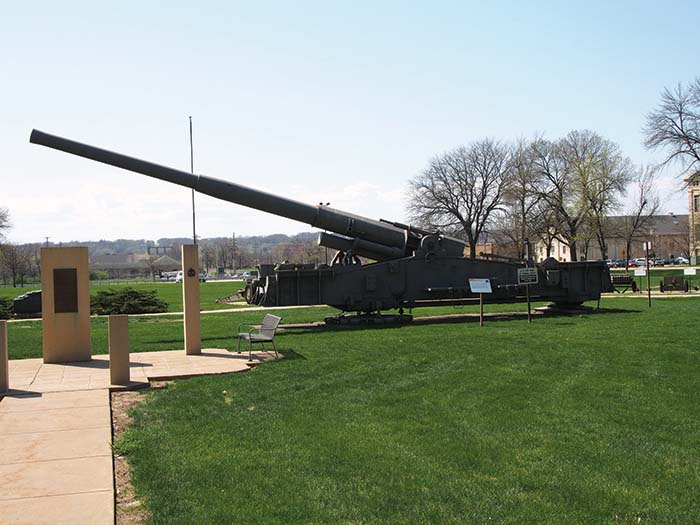
According to the museum’s records this example has the serial number 1, and was likely fabricated on December 20, 1904 but has the stock dated as 1905 and marked “CN/1905.” This cartouche actually indicates that the rifle was inspected in the fiscal year 1905. It has been in the museum’s collection ever since it passed this inspection.
From the very old to the new the museum also has on display a very rare example of the General Officers M15 Pistol, which was designed at the Rodman Laboratories at the Rock Island Arsenal. Only 1,004 of these were produced on the island from 1972 to 1974 and these were designed to replace the Colt “Model M” .32 and .380 caliber “pocket pistols” that had been issued to General Officers since 1941.
These pistols were all rebuilt Model 1911A1 pistols that were produced by the same armorers at the Rock Island Arsenal, but featured a shortened barrel and slide, distinctive horizontal grooves on the back grip and checkering on the front grip strap.
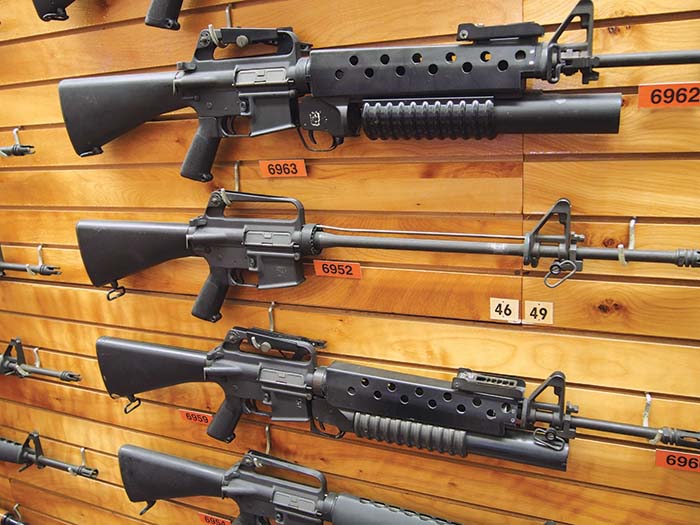
The collection also includes several M1919 .30 caliber Browning machine guns. The Rock Island Arsenal produced these beginning in 1938 with the M1919A4 air cooled confirmation being the most common model to pass through the armories and production continued throughout World War II.
Another item developed at the Arsenal was the “Brunton Bump,” that was designed to allow left-handed shooters to fire an M16/M4 without having the shell casing fly across the shooters’ face. It was designed by Loren H. Brunton of the small arms branch at the Rock Island Arsenal, and he even holds two patents for the design of this unique and very necessary feature.
American Small Arms
The Rock Island Arsenal Museum is of course devoted to the history of American small arms. Housed in its collection are some truly unique pieces and these include three of the only known examples of the Pederson Device, which was developed during the First World War to convert the Model 1903 rifle from a bolt action into a semiautomatic rifle.
Known officially as the “Automatic Pistol, Caliber .30 Model of 1918” in an attempt to keep the design and manufacture a secret, it utilized a special 40-round magazine that held the .30 caliber pistol cartridge. The rifle had to be slightly modified to use the Pederson Device and was re-designated as the Model 1903 Mark I.
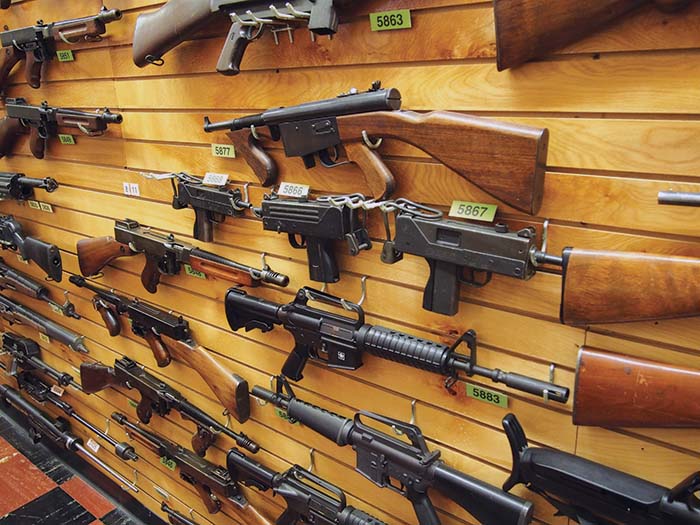
“These are the holy grail for our collection,” said Eric Kramer, public affairs director for the Rock Island Arsenal. “I know of only three others that are in private collections but we are fortunate to have three in our collection.”
The Rock Island Arsenal Museum also features several notable prototypes including a Model 1919 submachine gun that was built by the Auto-Ordnance Corporation in 1919. The example, serial number 6, is one of just a handful of known examples of the prototypes of the firearm that would go on to become the Thompson submachine gun.
While Eugene Stoner’s AR-15, later the M16, was not designed or produced at the Rock Island Arsenal the museum does have several notable pieces in its collection, which showcase the development and evolution of this firearm from the 1960s to the modern M4 versions.
The collection also features numerous versions of the M79 grenade launcher and examples of the MAC 10/11; but a visitor favorite remains a gold plated M60 machine gun that marked the end of the firearm’s production run. It is made of unserviceable parts and thus is one of the firearms in the collection that couldn’t actually fire, and attempts to remove it from permanent display have created a problem. “People keep asking to see the ‘gold gun,” said Leinicke.
International Weapons
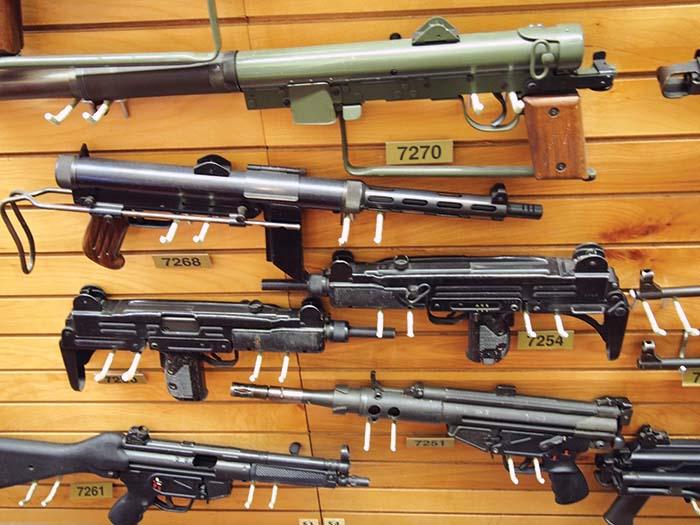
The collection is not limited to American firepower – and the museum has several notable pieces on display including a mid-19th century Japanese matchlock to several variations of the British Sten gun. Among the standout pieces of international firearms are those that were developed by America’s enemies and rivals in the 20th century.
These include several examples of German firearms from both World Wars including variations of the MP-18/I and MP-28/II as well as the MP40, MG34 and MG42 machine guns. The most impressive standouts in the German collection is that the museum features three versions of the FG42 (Fallschirmjägergewehr 42 or “paratrooper rifle 42”), which was one of the most advanced small arm designs of the Second World War. Only some 6,000 of these were produced during the war and three are now in the museum’s collection.
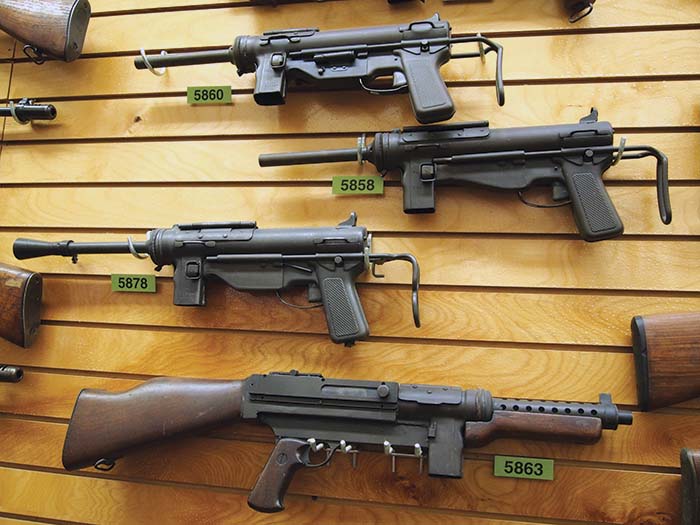
In addition to the FG42 the museum also has three MP44/StG44 “Sturmgewehr” examples in the collection. These were the first true “assault rifles” developed and had a major impact on modern infantry small arms development. While it has been argued that the AK47 was not a copy of the StG44 – the weapons have different mechanisms – it is true that the Soviets closely examined the thousands of captured weapons and these likely did play a role in Soviet Cold War small arms development.
The Rock Island Arsenal has several notable examples of these Soviet weapons including AK47 variations, but also other small arms including the PPSh41, DP28 and SKS.
With so many firearms it is hard to take in everything on one visit, but even to Leinicke it is really more than just a museum. “This is really a library of small arms as much as it is just a really good museum.”

Beyond the Museum
The museum is just one small component of the Rock Island Arsenal – the 946 acre island located on the Mississippi River. In fact the history of the government presence here goes back to 1816 with the construction of Fort Armstrong, which was one of the first western frontier defenses that were erected by the U.S. Army after the War of 1812. The Island later served as a prisoner of war camp during the American Civil War. Today the island is the final resting place for some 2,000 Confederate prisoners.
Since the 1880s, the Rock Island Arsenal, which is largest government-owned weapons manufacturing armory in the country, has produced various military equipment and ordnance including the M198 and M119 towed howitzers, as well as the Anglo-American Liberty Mark VIII tanks that were manufactured just after the First World War. Unfortunately none of these first American-made tanks has survived to the modern day, but the Rock Island Arsenal does have several other large pieces on display at the Memorial Field. In total 31 ordnance systems are on permanent display and these include an M119 howitzer, M51 anti-aircraft gun, an M50 anti-tank gun and even an M65 Atomic Cannon. This is the islands way of showing off its “big guns.”
| This article first appeared in Small Arms Review V19N7 (September 2015) |



